

 The South African
The South African
For the Natal Carbineers, 2005 marks 150 years of existence and service to South Africa. The Regiment was formed in January 1855, and this significant milestone is being commemorated with some fanfare. 2005 also marks the beginning of the second decade of democracy in South Africa, and the Carbineers, along with other sister Reserve Force units, continues to chart a challenging path towards a meaningful role in the South African National Defence Force.
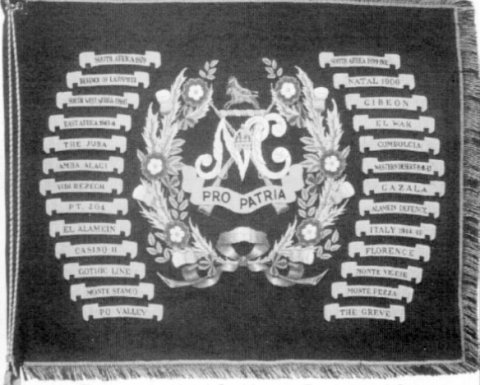
The current Natal Carbineers Regimental Colour,
with its familiar 26 theatre and battle honours.
One of the many functions envisaged for the 150th anniversary year of the Natal Carbineers is the presentation of a new Regimental Colour for the Regiment. This will replace the 'veteran' that has done sterling service since its presentation in the Drill Hall, Pietermaritzburg, by Combat-General Alan Fraser, on 20 May 1966.
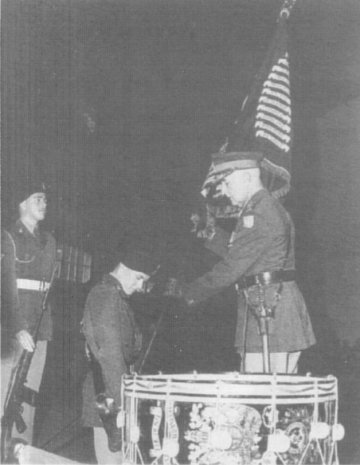
Combat-General Alan Fraser presents
the current Regimental Colour, 20 May 1966.
The 1966 Colour has served the Regiment well, highlights being the annual Retreat Ceremonies at Pietermaritzburg's Royal Show, numerous Troopings of the Colour and, perhaps most significantly of all, the parades at Durban International Airport in March 1995 in honour of Her Majesty Queen Elizabeth II. The monarch, a former colonel-in-chief of the Regiment, was in South Africa on her first visit to the country since 1947, and the first in her capacity as Queen. Combined detachments and colour parties of the Natal Carbineers and the Durban Light Infantry, the former 'Royal' regiments, paraded at Durban International Airport to greet her on arrival in KwaZulu-Natal, and again on her departure for the United Kingdom. On this important occasion, State President Nelson Mandela paid specific tribute to the two units.
To mark a century and a half of service, the venerated symbol of regimental prestige and espritde-corps, the Regimental Colour, has been upgraded by adding a further nine battle honours to the existing 26 campaign and battle honours - itself a record for a South African regiment. Although an impressive array of honours adorned its 1925 Standard (in the days when it was a mounted regiment) and its 1966 Colour, the Natal Carbineers has always sought to add to this collection. Launched in the mid-1990s under the inspiration and guidance of Major Keith Archibald, second-in-command at that time, the successful campaign for the nine additional honours that have been squeezed onto the proposed new replacement Colour, is the latest episode in a saga that stretches back to the aftermath of the First World War (1914-18).
The battle for additional honours
The 'battle' for additional battle honours for the Natal Carbineers has taken several forms. One obstacle concerned the issue of the award of battle honours earned by long disbanded units, such as those South African Infantry (SAI) and South African Horse regiments that served in East Africa and France during the First World War. This issue, which affected the Active Citizen Force as a whole, was placed on the table in 1924-5, and the decision was taken not to seek honours based on the scattered post-German South West Africa service, in regiments such as the SAI family, of members of units such as the Carbineers. Up to this point, therefore, the Carbineers were entitled to the honours 'South Africa 1879', 'South Africa 1899-1902', 'Defence of Ladysmith', and 'Natal 1906', to which 'South West Africa 1914-15'and 'Gibeon'were to be added. This issue was revisited in 1986, and the original decisions were confirmed.
The debate surrounding battle honours next surfaced in 1957, following the publication in Union Defence Force Orders, on 1 November that year, of the honours awarded to Union Defence Force units for 1939-1945, as well as for the Korean War. The illustrious Carbineers had little reason to be displeased, with the addition of no fewer than nineteen campaign and battle honours, from East Africa 1940-1941 to Po Valley. This was more than any other South African regiment, the Imperial Light Horse, with seventeen, coming a close second.
Nevertheless, despite the accolade of nineteen honours, the Carbineers were dissatisfied, and immediately fired off a salvo of queries. What, asked the Regiment, about Taieb el Essem and Bir Sciafsciuf in the Western Desert during November 1941, Bir el Gubi (December 1941), Tobruk (June 1942), Qattara Track (July 1942), Paliano, Bagno Regio and Citta delia Pieve in June 1944, The Greve (July-August 1944), and Monte Salvaro in October 1944?
Defence Headquarters was 'not prepared to enter into arguments with individual units on the merits of the actions' and reminded the Carbineers that 'the Battle Honours were awarded by a committee consisting of very senior officers who proceeded most meticulously and conscientiously, with superior knowledge, and made their decisions only after careful consideration.'
In response to the Regiment's entreaties, the Department of Defence emphasised the two critical factors that were taken into consideration - adequate representation, and tactical importance. There the matter appeared to rest ...
The second battle
The Carbineers were not, however, going to allow the issue to remain dormant forever and, in the last decade of the twentieth century, Major Archibald duly took up the cause again. Several of what the Carbineers saw as 'omissions' formed the basis of a concerted research campaign in conjunction with the Department of Defence's Documentation Centre and the Defence Command Council. The Regiment was ambitious in the extent of its claim for another nineteen honours! Applications that failed this new, and presumably final, round of selection were: Yonte (February 1941); Jalo (November 1941); Bir El Gubi (December 1941); Agedabia (December 1941-February 1942); El Marassas (June 1942); Tobruk (June 1942); Mersa Matruh (June 1942); Alem El Haifa (AugustSeptember 1942); Rome (May-June 1944); The Tiber (May-June 1944); and Monte Salvaro (October 1944).
The successful new claims, nine of them, are detailed in the revised list of Carbineer honours that follows.
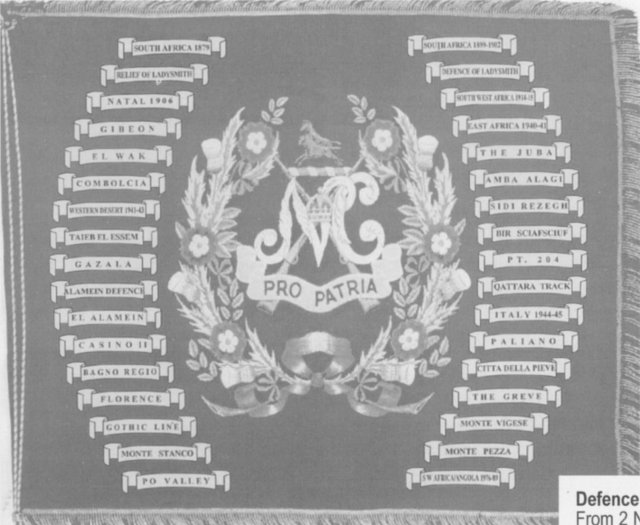
Hailing a new era: The proposed new Regimental Colour for the Natal Carbineers
(Photo: By courtesy Natal Carbineers).
South Africa 1879
The Natal Carbineers participated in the invasion of Zululand in January 1879 and, on 22 January, 23 members of the Regiment perished in the famous battle at Isandhlwana. The unit was subsequently relegated to garrison duties at Landman's Drift on the Mzinyathi/Buffalo River.
South Africa 1899-1902
In September 1899, the Natal Carbineers was mobilised for active service in the British campaign to subdue the Boer Republics of the Transvaal and Orange Free State. The Regiment served until October 1900, when the Natal Volunteer Forces were demobilised. Some men continued their service in the Volunteer Composite Regiment until the end of the War in May 1902.
Defence of Ladysmith
From 2 November 1899 until 28 February 1900, the bulk of the Natal Carbineers was besieged in Ladysmith, and played a prominent part in that famous siege. The most prominent military action. was the attack by Colonial Forces on the Boer artillery emplacement at Gun Hill on the night of 7/8 December 1899. The Regiment lost men heavily from the diseases that ravaged the garrison.
Relief of Ladysmith (additional honour that will feature on new Colour)
A solitary squadron of the Natal Carbineers, the EstcourtWeenen Squadron, avoided the siege of Ladysmith and, instead, participated in the relief operations of Sir Redvers Buller. This squadron's most notable military action of this period was the disastrous battle of Colenso on 15 December 1899, when four men were killed. These were the most serious losses for anyone action during the Anglo-Boer War (1899-1902).
Natal 1906
The Natal Carbineers saw extensive service in the Natal (or Bambatha) Uprising of 1906. From February to July 1906, the Regiment participated in the numerous sweeps and drives through the mountainous terrain of Zululand, as the Natal Colonial forces sought to trap and destroy the elusive rebel warriors. The Carbineers were present at the decisive battle at Mhome Gorge on 10 June, where the back of the uprising was broken.
South-West Africa 1914-1915
The Natal Carbineers, then known as the 1st and 2nd Mounted Rifles, was mobilized for war service on 23 August 1914. Both battalions saw service in German South West Africa, while the 2nd Battalion was also involved in the suppression of the shortlived Afrikaner Rebellion of 1914. The campaign in South-West Africa was characterised by arduous marches over desolate desert terrain.
Gibeon
The climactic battle of the South African campaign in German South-West Africa was fought at Gibeon Station on 25 April 1915. The Carbineers lost two men killed in the engagement.
East Africa 1940-1941
On 17 July 1940, the 1st Royal Natal Carbineers sailed for Kenya as part of the 1 st South African Brigade. Their destination was the Italian colonial empire in East Africa. For the next ten months the Regiment participated in the South African advance through Italian Somaliland and Abyssinia, until Italian resistance was broken at Amba Alagi in May 1941.
El Wak
The first major engagement of the East African campaign for the Carbineers was fought on 16 December 1940 at the Italian border post of EI Wak, on the northern Kenyan frontier with Italian Somaliland. The Regiment lost its first Second World War casualty, Sergeant Athol Paton, in this otherwise successful clash.
The Juba
The Juba River was the Italian Army's major defensive line in Somali land. Several actions were fought during January and February 1941, at Gobwen and Giumbo, but the period is best remembered for the disastrous ambush on 22 February of a Carbineer patrol at Gelib. Twelve men lost their lives, the Regiment's severest losses in a single engagement during the Second World War.
Combolcia
The engagement at Combolcia in Abyssinia on 22 April 1941 followed the occupation of the Abyssinian capital, Addis Adaba, in March. The fighting at Combolcia was distinguished by a daring and successful nocturnal route march to outflank Italian mountain-top positions. The battle honour awards refer to the general period 17 to 25 April.
Western Desert 1941-1943
Following the fall of the Italian East African Empire in May 1941, the 1st South African Brigade was dispatched to North Africa to confront the joint Italian-German forces in the see-saw offensives across Egypt and Libya. The Carbineers earned numerous individual battle honours between June 1941 and January 1943 when it sailed home for a well-earned leave.
Sidi Rezegh
The 1st Royal Natal Carbineers played a small part in the disastrous battles in the vicinity of Sidi Rezegh in Libya from 19 to 23 November 1941. These actions formed part of Operation Crusader, the British offensive of November/December 1941, intended to relieve the first siege of Tobruk.
Amba Alagi
Italian resistance in East Africa was finally crushed when the mountain fortress of Amba Alagi, between Dessie and Asmara, was successfully stormed by British and Commonwealth forces that included the 1st Royal Natal Carbineers. The Italians surrendered on 17 May 1941, and this battle honour refers to the period from 11 to 19 April.
Point 204
This little-known clash occurred in the Alem Hamza area of the Gazala Line on 5 June 1942. The single company involved suffered heavy casualties in a clash with Italian troops. Among the six killed was HP Masterton-Smith. the 1931 Comrades Marathon winner.
Taieb el Essem (additional honour that will feature on new Colour)
The Carbineers was a component of the 1st Brigade force that held a defensive box south of Sidi Rezegh. On 24-25 November 1941, this force repelled a heavy German armoured assault. The engagement immediately entered Carbineers' folklore, and its initial omission from the World War battle honours was particularly resented.
Gazala
The Gazala Line, to the west of Tobruk, established in early 1942, was a series of connected strong-points intended to blunt a German thrust towards Egypt. Carbineers formed part of the garrison of this line from March to June 1942, when they were forced to retreat after a German breakthrough and the fall of Tobruk. The major highlight of the Gazala sojourn was the patrol on 5 June when Sergeant Quentin Smythe earned the VC.
Alamein Defence
Following the breaching of the Gazala Line and the fall of Tobruk, British and Commonwealth forces retired to El Alamein, not far from Alexandria in Egypt. Here a comprehensive series of defences were prepared. In July 1942 the Carbineers played its part in denying the Germans the breakthrough here that they needed to attain victory in this theatre.
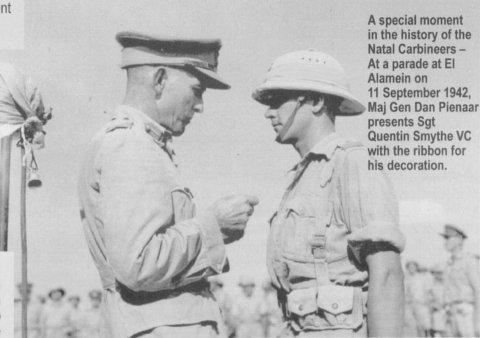
A special moment in the history of the Natal Carbineers. At a parade at El Alamein on 11 September 1942,
Maj Gen Dan Pienaar presents Sgt Quentin Smythe VC with the ribbon for his decoration.
Qattara Track (additional honour that will feature on new Colour)
On 26-27 July 1942 a detachment of the Carbineers was involved in this subsidiary action in the Alamein defensive battles of July 1942. These series of engagements were pivotal in blunting the eastward rush of Field-Marshal Erwin Rommel's Afrika Korps in the wake of the fall of Tobruk in June that year.
Bir Sciafsciuf (additional honour that will feature on new Colour)
This minor engagement on 30 November 1941 was another episode in the Crusader offensive. A small Carbineer component was pitted against an enemy convoy in the vicinity of Sidi Rezegh.
El Alamein
The Carbineers played a small but eventful part in the huge and decisive Second Battle of Alamein in October-November 1942. The Carbineer participation was confined mainly to the initial phase launched on 23 October.
Italy 1944-1945
The 1st Royal Natal Carbineers landed at Taranto, Italy, on 20 April 1944, just in time for the latter phases of the battles for Cassino. From there, the Regiment fought its way up the Italian boot, through Rome, until final victory in May 1945.
Cassino II
The task of breaching the German Gustav Line, straddling southern Italy, was dominated by the mountain position of Cassino, under assault since January 1944. The Carbineers entered the fray in May, and it was on the night of the 9/10 May that the Regiment's first casualty in Italy, Corporal JSP Airey, was killed. The Carbineers remained active on the Cassino line for several weeks until 21 May. This battle honour refers to the general period of 11 to 18 May 1944. Cassino is widely acknowledged as the bloodiest battle of the War between the Western Allies and German forces.
Paliano (additional honour that will feature on new Colour)
Two companies of the Carbineers were involved in this action along Route 6 during the advance from Cassino to Rome, as German forces fought several rearguard actions.
Bagno Regio (additional honour that will feature on new Colour)
Bagno Regio was a hilltop village north of Rome and, on the night of 12-13 June 1944, elements of the Carbineers scaled a precipitous rock face to effect its capture. The skill and daring displayed in this operation earned the Regiment considerable renown.
Citta delia Pieve (additional honour that will feature on new Colour)
The action at Citta delia Pieve occurred during the period 16 to 19 June 1944 during the Allied advance north of Rome. Two companies of the Carbineers lost a total of eight men killed.
Monte Vigese
Monte Vigese was a seemingly impregnable rocky eminence occupied by entrenched German forces. On 6 October, however, in driving rain and poor visibility, 'A' Company, under Major Peter Francis, performed the virtually impossible task of driving the defenders off. Vigese was one of the hardest fought Carbineer engagements of the Italian campaign.
Florence
Following the fall of Rome on 5 June 1944 German resistance stiffened in the vicinity of Florence, and during June there were several sharp actions, such as those at Bagno Regio and Chiusi. The battle honour covers the period from 17 July to 10 August. This activity was followed by a period of rest during August.
The Greve
The action at the Greve, a river north of Rome, was fought over the period 24 July to 2 August 1944.
Monte Stanco
On 10 October, at Monte Stanco, the Carbineers suffered one of its few reverses of the Italian campaign, when it was compelled to abandon this hard-won feature. Captain Jacko Edmonds earned the American Silver Star for gallantry for his part in this action.
Gothic Line
The Gothic Line was another of the German defensive lines that straddled the boot of Italy as the Allied armies pushed relentlessly northwards from Rome in mid to late1944. The Gothic Line Carbineer battles fought in the effort to breach it, and thereafter, have entered the Regiment's hall-of-fame: Monte Vigese, Monte Stanco, Monte Pezza, and others.
Monte Pezza
Monte Pezza was the next peak in the Gothic Line to be tackled by the 1st Royal Natal Carbineers, on 17 October 1944.
Po Valley
Following a long and hard winter in the snow-bound Apennines, the campaign to drive the Germans out of the rest of Italy, the fighting entered the Po Valley, and the Carbineers once again played a significant part in operations from 19 to 30 April 1945.
South West Africa / Angola 1976-1989 (additional honour that will feature on new Colour)
The Natal Carbineers saw service in a counter-insurgency capacity in the Operational Area of northern Namibia (South West Africa) for three months from 9 August 1976, and again in the following year from 18 July 1977, mostly in 2 Military Area (later Sector 10). Thereafter, from 1978 to 1983, the unit despatched several modular companies to the Operational Area,
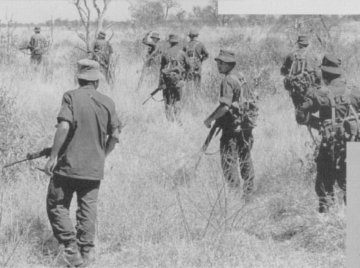
On patrol in the bush in the Operational Area in northern South West Africa (Namibia).
Return to Journal Index OR Society's Home page
South African Military History Society / scribe@samilitaryhistory.org